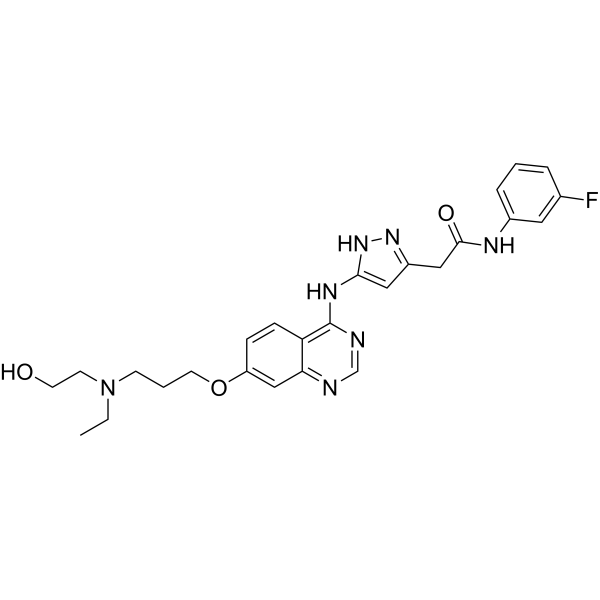Home
Products
Barasertib (AZD1152-HQPA)



| Product Name | Barasertib (AZD1152-HQPA) |
| Price: | Inquiry |
| Catalog No.: | CN00369 |
| CAS No.: | 722544-51-6 |
| Molecular Formula: | C26H30FN7O3 |
| Molecular Weight: | 507.56 g/mol |
| Purity: | >=98% |
| Type of Compound: | Alkaloids |
| Physical Desc.: | Powder |
| Source: | |
| Solvent: | Chloroform, Dichloromethane, Ethyl Acetate, DMSO, Acetone, etc. |
| SMILES: | OCCN(CCCOc1ccc2c(c1)ncnc2Nc1[nH]nc(c1)CC(=O)Nc1cccc(c1)F)CC |
| Contact us | |
|---|---|
| First Name: | |
| Last Name: | |
| E-mail: | |
| Question: | |
| Description | AZD1152-HQPA is a highly selective Aurora B inhibitor with IC50 of 0.37 nM in a cell-free assay, and appr 3700 fold more selective for Aurora B over Aurora A. |
| Target | Aurora B:0.37 nM (IC50) |
| In Vitro | AZD1152 displays >3000-fold selectivity for Aurora B as compared with Aurora A which has an IC50 of 1.368 μM. AZD1152 has even less activity against 50 other serine-threonine and tyrosine kinases including FLT3, JAK2, and Abl. AZD1152 inhibits the proliferation of hematopoietic malignant cells such as HL-60, NB4, MOLM13, PALL-1, PALL-2, MV4-11, EOL-1, THP-1, and K562 cells with IC50 of 3-40 nM, displaying appr 100-fold potency than another Aurora kinase inhibitor ZM334739 which has IC50 of 3-30 μM. AZD1152 inhibits the clonogenic growth of MOLM13 and MV4-11 cells with IC50 of 1 nM and 2.8 nM, respectively, as well as the freshly isolated imatinib-resistant leukemia cells with IC50 values of 1-3 nM, more significantly compared with bone marrow mononuclear cells with IC50 values of >10 nM. AZD1152 induces accumulation of cells with 4N/8N DNA content, followed by apoptosis in a dose- and time-dependent manner[2]. AZD1152-HQPA treatment induces defective cell survival, polyploidy, and cell death in LNCaP cell line. AZD1152-HQPA also decreases expression of AR[3]. |
| In Vivo | AZD1152 (10-150 mg/kg/day) significantly inhibits the growth of a variety of human solid tumor xenografts, including colon, breast, and lung cancers, in a dose-dependent manner[1]. Administration of AZD1152 (25 mg/kg) alone markedly suppresses the growth of MOLM13 xenografts, confirmed by the observation of necrotic tissue with infiltration of phagocytic cells[2]. |
| Cell Assay | Cells are exposed to various concentrations of AZD1152 for 24 or 48 hours. Cell proliferation is measured by 3H-thymidine uptake (isotope added 6 hours before harvest), and the concentration that induced 50% growth inhibition (IC50) is calculated from dose-response curves. Cell cycle analysis is performed by flow cytometry. Cell apoptosis is measured by annexin V–FITC apoptosis detection kit. |
| Animal Admin | Human tumor xenografts are established by s.c. injecting 100 to 200 μL tumor cells (between 1×106 and 1×107 cells mixed 50:50 with Matrigel) on the flank. Animals are randomized into treatment groups (n=8-11 per group) when tumors reach a defined palpable size (0.2-0.3 cm3 and 0.5-1 cm3 for mice and rats, respectively). AZD1152 is prepared in Tris buffer (pH 9) and administered either as a bolus injection (i.v. or i.p.) or as a continuous 48-h infusion via s.c. implanted osmotic mini-pumps (two 24-h pumps implanted sequentially) in accordance with the manufacturer's instructions. Tumors are measured up to three times weekly with calipers, tumor volumes are calculated, and the data are plotted using the geometric mean for each group versus time. Tumor volume and tumor growth inhibition are calculated. Statistical analysis of any change in tumor volume is carried out using a Student's one-tailed t test (P value of <0.05 is considered to be statistically significant). |
| Density | 1.4±0.1 g/cm3 |
| Boiling Point | 796.7±60.0 °C at 760 mmHg |
| Flash Point | 435.6±32.9 °C |
| Exact Mass | 507.239410 |
| PSA | 128.29000 |
| LogP | 2.82 |
| Vapour Pressure | 0.0±2.9 mmHg at 25°C |
| Storage condition | 2-8°C |